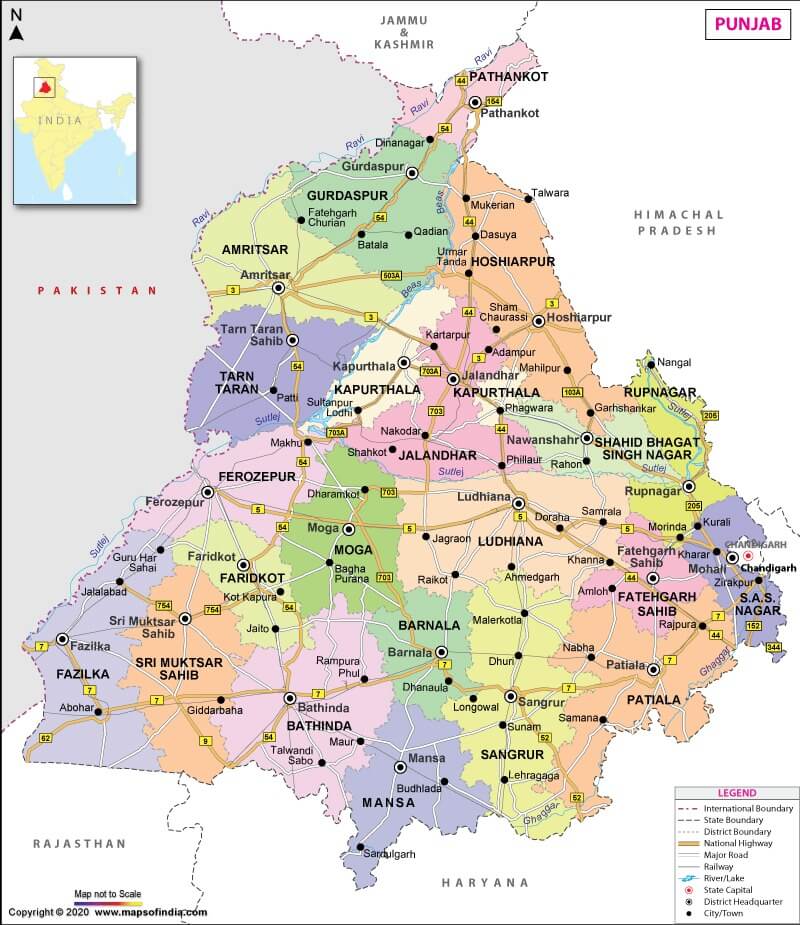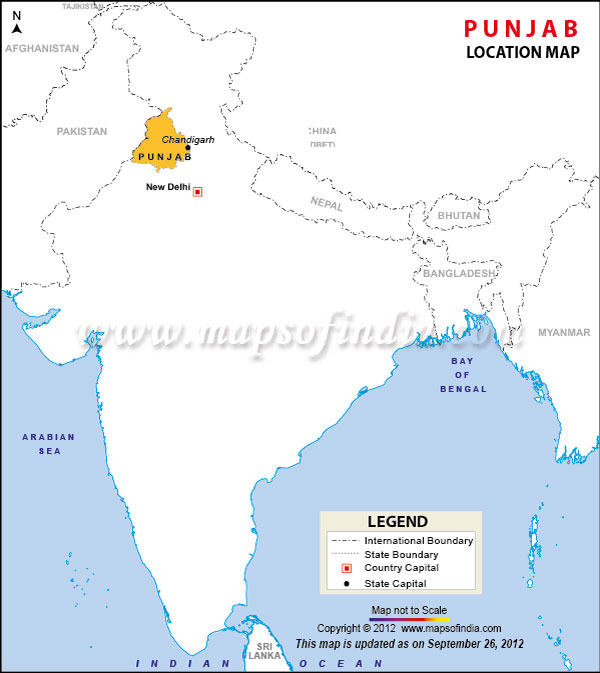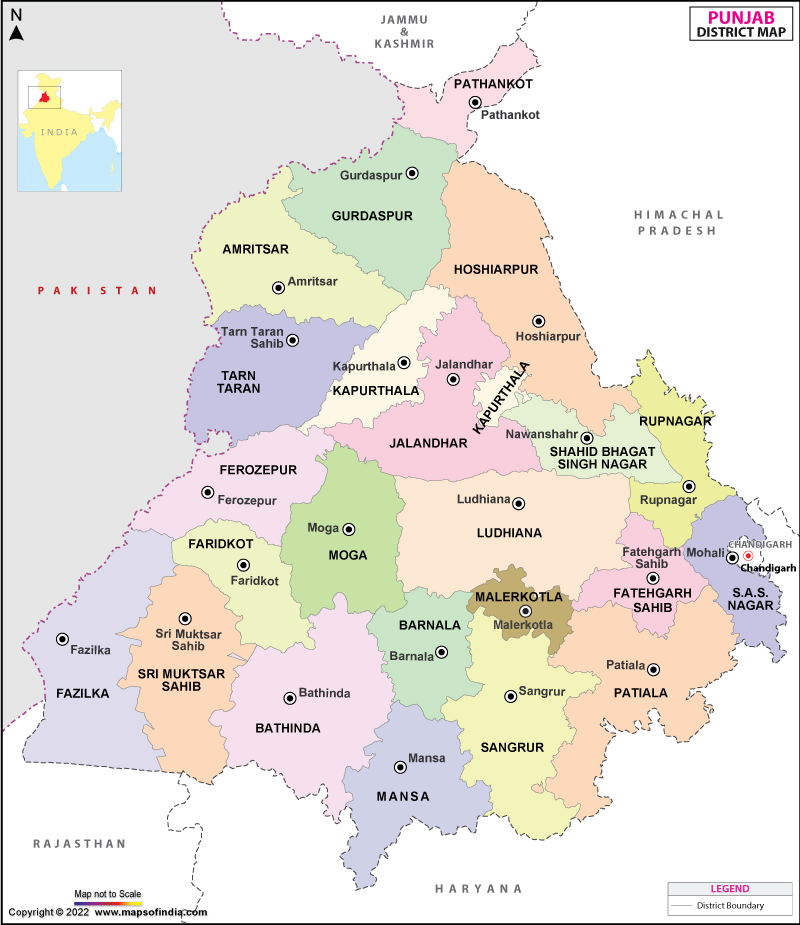

Where is Punjab?
Punjab is in the northwestern part of India and was initially called Sapta Sindhu. The states of Jammu and Kashmir adjoin Punjab to the north, Himachal Pradesh to the northeast, Haryana to the south and southeast, Rajasthan to the southwest and neighbouring country to the west. Chandigarh (Union Territory) is the capital of Punjab. Both Punjab and Haryana share the capital city of Chandigarh.
The demographic majority in this state are Punjabi speaking population. The main religions of this state are Sikhism and Hinduism. Some other religious groups there in the state are Buddhism, Zoroastrianism, Jainism, Christianity, and Ravidassia. The Punjabi culture and traditions are also known as the breadbasket of both India and Pakistan.
Some of the festivals of Punjab are Maghi, Holi, Diwali, Bandi Chhor Divas, Basant, Lohri, Maha Shivratri, Vaisakhi, Teeyan, Raksha Bandhan, Gurupurab, Hola Mohalla, Mela Chiraghan, Dussehra, Katwa Chauth, Navaratri, to name a few.
What is the Geography of Punjab?
Punjab spreads in an area of 19,445 square miles (50,362 square km) with a population of 27,704,236 as per the 2011 census. The state divides into three physiographic regions: Siwalik Range in the northeast (smallest) with an elevation reach about 3,000 feet (900 meters). To the south is the narrow, oscillating foothill region, which is anatomized by closely spaced seasonal flood, colloquially known as Chos. Further, a vast flat track also lies in the south and west of the foothills, that is at a low altitude floodplain detached by slightly elevated uplands. This region has high – yielding alluvial soils, slopes gently from an elevation point of 900 feet (275 meters) in the northeast to about 550 feet (170 meters) in the southwest.
What is the Climate of Punjab?
Considered to be one of the most fertile regions on Earth, Punjab’s climate also contributes to its economy. It has a non-coastal subtropical location with a continental climate. In this state, June is the hottest month when the temperature soars up to 40° C (Jalandhar). The coldest month is January when the mercury drops to 6.7° C. The rainy seasons lasts from July to September (southwest monsoon). While the Shivalik range receives an annual rainfall of 45 inches (1,150 mm), and the southwest gets less than 12 inches (300 mm). The statewide average annual precipitation is 16 inches (400 mm). Winter rains occur from December to March from the western cyclone that accounts for less than one – fourth of the total rainfall. The state gets heavy showers and hailstorms during the transitional period from winter to the summers.
What is the Economy of Punjab?
As mentioned earlier, Punjab is one of the most fertile regions in India. It produces a relatively high proportion of local Indian and Pakistani foods than the rest of the states. The area is used for extensive and commercial farming of wheat, rice, cotton, vegetables, and fruit. About two-fifths of the state’s population is engaged in the agricultural sector, which accounts for an essential segment of the state’s gross product. Punjab’s agrarian progress and its capacity is a pin on the Green Revolution, an agricultural revolution between 1950 to 1960s that initiated new agrarian technologies but also high-yielding varieties of wheat and rice. Punjab is also one of the most widely irrigated states. The primary source of irrigation here are wells (mostly used in north and northeast) and government-owned canals (southern and southwestern). Bhakra Dam in Himachal Pradesh supplies most of Punjab’s irrigation water.
Punjab also has power plants, and it draws power from thermal power plants and hydroelectric power plants. From the 21st century, the demand for electricity has increased in the state.
Some of the manufacturing industries in Punjab are food and beverage, silk, wool, transport equipment, and furniture.
The service sector of Punjab includes real estate, public administration, transport and storage, financial services, to name a few.
What is the Transportation System of Punjab?
Punjab has one of the best-developed road networks. It also has a significant number of national highways passing through the state. The rail network of Punjab is part of the national railway system. Punjab’s international airport is in Amritsar and has several other airports that offer cargo services as well.
What are the Popular Tourist Attractions of Punjab?
Some of the best places to visit in Punjab are Amritsar, Chandigarh, Ludhiana, Jalandhar, Bhatinda, Patiala, Kapurthala, Pathankot, Nangal, Ropar, Mohali, Sirhind, to name a few.
Some of the tourist attractions are Golden Temple, Jallianwala Bagh, Wagha Border, Maharaja Ranjit Singh War Museum, Museum of Rural Life, Phillaur Fort, Museum of Rural Life, Devi Talab Mandir, Niku Park, Quila Mubarak, Rose Garden, Jogger’s Park, Moti Bagh Palace, Kali Mata Mandir, Shalimar Gardens, Moorish Mosque, Kanji Wetland, Anandpur Sahib, Rose Garden, Sukhna Lake, Mansa Devi Temple, Tomb of Nabis at Bras, etc.
Related Maps:



